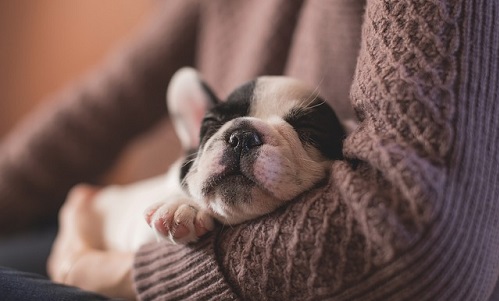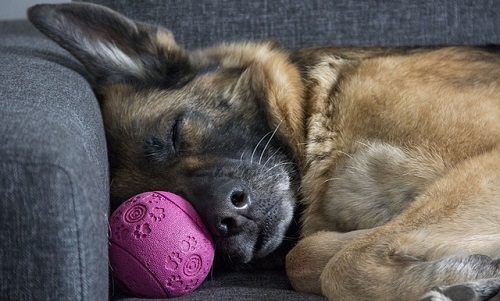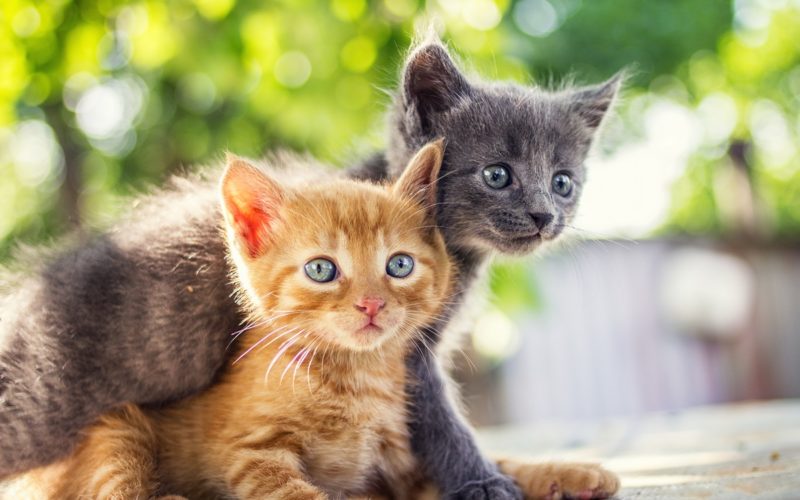You’ve probably watched your dog do some rather bizarre things while sleeping that may make you wonder, “Do dogs have dreams?” Sometimes dogs may unexpectedly start vocalizing, either barking, whimpering or growling in their sleep. Sometimes dogs shake, quiver, and twitch. Some dogs even behave as though they are running, with their legs pumping in the air as they snore away. Occasionally dogs have even been known to snap at the air in their sleep, like they are trying to bite something or someone only they can see.
Based on canine research, it’s highly probable that dogs do in fact dream. Even cooler, they actually may dream in the same or similar ways that humans dream, by replaying the prior day’s events during their sleep cycle. This is because structurally, dogs have brains that are a lot like humans. When a dog is sleeping, brain wave patterns that resemble the same as humans exhibit while sleeping can be observed. Dogs appear to go through the same stages of electrical and brainwave activity while sleeping that people go through, which points to the probability they are in fact dreaming.
Psychology Today actually says it would be surprising if dogs didn’t dream, because it’s been observed that even simple-minded rats appear to dream in a similar way as humans, and dogs are more intelligent than rats. The American Kennel Club cites a study from researchers at MIT where rats were trained to run a maze. They monitored the rats during REM sleep and observed their brain activity. REM sleep is the time in the sleep cycle humans dream. According to the study, the findings showed the rat’s brain activity was the same as the activity displayed when the rats were running, which leads to the conclusion that the rats were dreaming about their day and the maze they’d run through before sleeping.
What are Dreams?
Dreams are still a bit of a mystery. Most experts believe they are subconscious imaginings that could be related to emotions, memories, and/or past events. A dream can include vivid sensory experiences like colors, sounds, and images. Sometimes (with humans at least), dreams can be so vivid they can be mistaken for reality.
Other experts think that dreams may be a way to process information. This information could be associated with whatever you did that day or even something you did years ago in the form of repressed or forgotten memories. Dreams can be confusing and frightening or seem perfectly real and rational.
Some experts believe that dreams are necessary for optimal health, both mentally, physically, and emotionally, whereas other researchers think that dreams serve no real purpose or function and are just a byproduct of the sleeping imagination. Still other experts believe that dreams are a blend of both memories and experiences, although they aren’t exactly memories of experiences. They are more like puzzle pieces of memories and experiences, put together in the brain in new and different ways that help dogs (and people) learn from their environment and experiences.
Either way, it’s agreed all across the board that dreams are tricky and complex. Until new breakthroughs in the science behind dreams occur, they may remain so for the foreseeable future.
Do Dogs Dream Differently Than Humans?
 Though there are many similarities between dogs and humans, dogs do dream a little bit differently. Dogs experience sleep cycles in the same manner humans do, although their cycles operate a bit differently than ours. It appears that like people, dogs dream during the REM (or rapid eye movement) stage of sleep. But the REM stage occurs at different points in the cycle with dogs. Whereas a human may have five 90 minutes full sleep cycles in a night, dogs are thought to have more frequent, shorter sleep cycles. It’s not uncommon for a dog to experience 20 sleep cycles in a night, averaging about 15 minutes each in length.
Though there are many similarities between dogs and humans, dogs do dream a little bit differently. Dogs experience sleep cycles in the same manner humans do, although their cycles operate a bit differently than ours. It appears that like people, dogs dream during the REM (or rapid eye movement) stage of sleep. But the REM stage occurs at different points in the cycle with dogs. Whereas a human may have five 90 minutes full sleep cycles in a night, dogs are thought to have more frequent, shorter sleep cycles. It’s not uncommon for a dog to experience 20 sleep cycles in a night, averaging about 15 minutes each in length.
This means that even though humans and dogs experience similar sleep stages, dogs sleep a lot more than humans. A dog’s sleep cycle starts with periods of wakefulness, followed by REM sleep, and then non-rapid eye movement sleep. Humans experience the same stages, but also dream during non-REM sleep. However, it’s the REM sleep dreams that are often vivid and weird and the most memorable. Whether dogs also dream during this non-REM phase of sleep is unknown, but if they are similar to humans in all other stages of sleep, then it’s possible they dream during this stage as well.
Could a Medical Condition Be Mistaken as Dreaming?
It could, but it’s not likely. A dog that is asleep and dreaming behaves much differently from a dog with a health problem or medical disorder such as canine seizures or REM behavior disorder. Even though a dog’s actions and movements during sleep can get somewhat excited, a dog that is having a seizure will behave in a way that is noticeably different. When a dog has a seizure, the movements of his body are jerkier, and they tend to be faster than sleep movements. Additionally, a dog that is having a seizure won’t be able to wake up from it when you call his name.
If a dog is merely sleeping and dreaming, when he hears you say his name he will awaken right away. Dogs experiencing REM behavior disorder will also behave in a way that’s different from dreaming. In REM behavior disorder, the pons doesn’t appear to work properly. So, a dog can remain sleeping yet still get up and walk around like they are awake. Much like humans that sleepwalk. If you suspect some kind of REM sleep disorder, it’s wise to talk to your vet and try to get an accurate diagnosis. Your vet can help you decide what course of treatment is best for your dog and how you can keep your dog safe in spite of their behaviors.
What Do Dogs Dream Of?
Currently, it’s a sort of “best guess” scenario. Many dream experts think that the brain uses dreams to process information and past events. Dreams may often recall memories of things that we experience when we are awake, whether it’s a memory of something that happened that day or last week. It’s thought that a dog’s dreams may be similar in that they recall events that have happened when they were awake too, and dream about them.
In both humans and dogs there is something in the brainstem called the pons. When it’s working, it keeps humans (and dogs) from acting out dreams physically. This is a good thing, because acting out dreams could get dangerous. An experiment was done where researchers deactivated the pons in dogs temporarily as a way to try to determine what dogs might be dreaming about when they fall asleep. The findings showed that dogs seemed to be clearly dreaming about life as a dog. When the pons were deactivated, they found the dogs would begin to move in their sleep during the REM stage associated with dreaming, even though they were still sleeping. Despite still being asleep, the dogs would move in real time, performing the action they appeared to be dreaming about.
For instance, if a dog was dreaming about digging a hole, or chasing something, or even fighting with another dog, with the pons deactivated, he would act it out even though he was still sleeping. Another interesting aspect about the REM stage of sleep is if you watch your dog closely, you can see when he enters this REM state and starts dreaming. During the REM sleep a dog’s eyes will move rapidly back-and-forth beneath the eyelids as images and memories are replayed in his mind. This phenomenon occurs with humans as well when they enter the REM state and begin to dream. Their eyes move back-and-forth beneath their lids, and sometimes you may notice little, involuntary muscle twitches and spasms in the body.
Do All Dogs Dream the Same?
Actually, it’s thought that smaller dogs may have more dreams than larger dogs even though those dreams may be shorter in duration. This appears to be related to the length of his sleep cycles. A smaller dog appears to dream more frequently, having a dream every 10 minutes during his sleep cycle. Whereas a larger dog will dream less often, having a dream every 90 minutes or so as he progresses through the sleep cycle and his dreams will last longer in duration.
 It’s also thought that what a dog does throughout his day may direct his dream state. Dogs that are trained to hunt and point will often display hunting and pointing behaviors while sleeping, whereas a guard dog may display guarding behavior in his dreams. A dog that likes to play fetch may exhibit fetching behavior during his sleep, indicating he is dreaming of chasing a ball and fetching it. So, whatever breed of dog you have and what he does all day, whether it’s something he is innately bred to do or it’s just something he does as a quirky habit, could make its way into his dreams.
It’s also thought that what a dog does throughout his day may direct his dream state. Dogs that are trained to hunt and point will often display hunting and pointing behaviors while sleeping, whereas a guard dog may display guarding behavior in his dreams. A dog that likes to play fetch may exhibit fetching behavior during his sleep, indicating he is dreaming of chasing a ball and fetching it. So, whatever breed of dog you have and what he does all day, whether it’s something he is innately bred to do or it’s just something he does as a quirky habit, could make its way into his dreams.
Puppies are also thought to dream more than adult dogs dream, which is possibly related to the massive amount of information puppies acquire in the first few months to a year of life. Puppies are like any other baby, little sponges soaking up their experiences and the quirks of the environment around them. The dream state may be the way a puppy processes all that new information and catalogs it within his mind. The same seems to hold true for senior dogs, they appear to dream more often than middle-aged dogs, although it’s not fully understood why.
Is It Dangerous to Wake a Sleeping Dog?
It can be dangerous to wake your dog if you know they are in the middle of a dream. It’s usually fairly easy to tell when a dog is dreaming, because of the involuntary movements and vocalizing they may do. Even though the pons is active and keeping their major muscles from moving, it has no control over smaller muscles that could still twitch and move while dreaming. If you wake a dog in the middle of a REM stage of sleep, they could be confused and act out. That means you could accidentally get bit before they are fully awake and aware of what they are doing, even if your dog has never shown signs of canine aggression. So, the best thing to do if you know your dog is dreaming is to let them sleep it out and wake up on their own.
Can a Dog Have Nightmares, Too?
Unfortunately, dogs can have bad dreams too. This is why it’s important not to wake your dog during the REM stage of sleep, because he could be having a dream that is bad or scary. It’s tough to watch a dog that appears to be trapped in a nightmare, you might instinctively want to wake your dog and comfort him, but that’s a bad idea. If you wake him in this state, he could inadvertently snap or bite you before he reorients himself and realizes he is safe with his humans.
Ultimately, a dog’s brain really isn’t so different from the human brain, so the question of do dogs dream can be answered with a resounding yes. The bigger question is determining what a dog dreams about and how those dreams may impact a dog’s health. If doggie dreams are anything like humans, they are an important part of the sleep process. Having healthy sleep patterns serve to help a dog not just survive but thrive.
Sources:
- “Do Dogs Dream?” Psychology Today, www.psychologytoday.com/us/blog/canine-corner/201010/do-dogs-dream.
- Donovan, Liz. “Do Dogs Dream?.” American Kennel Club, 9 Nov. 2015, www.akc.org/expert-advice/lifestyle/do-dogs-dream/.
- “Do Dogs Dream?” PetMD, 26 Sept. 2016, www.petmd.com/dog/general-health/do-dogs-dream.
- “Do Dogs Dream?” VCA Hospitals, www.vcahospitals.com/know-your-pet/do-dogs-dream.




